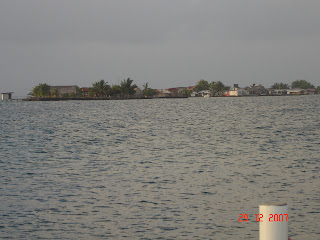
back to
the Kuna Yala homepageThe women own property in the jungle for growing food, but the men work the land,
The typically grow pineapple, coconuts, breadfruit plantains and other fruit. The Kuna´ diet consists mostly of nice and seafood. Their classic drink is chicha; these are made by boiling
water and corn.
Kuakas are hand carved and hulled out of large trees found in the jungle. They are then smoothed of all the splinters and hand painted with brigh colors. The Kuna either use ores to row the boats or attach sails. If they have enough money, then they affix a motor to the back.

Behing the Kuakas in the back of the photo there is a picture of a restroom. The facilities are built over the water, so the waste can into the ocean. Very Few islands have electricity or running water, but the ones that do sometimes have fluship commodes. Some families even build concrete restrooms and bathing facilities.
Political SystemThe Kuna have the most sophisticated organization of any tribal group in Latin America. They elect chiefs that manage the village´ politics and govern the community. The elected officials conduct meeting called "congresos" and during this time they make decisions for the village. Each village has at leat two chiefs and all San Blas is managed by an elected head chief and subordinate chieft.
 smoothed of the splinters and hand painted with bright colors. The Kunas either use ores to row the boats or attach sails. It they have enough money, then they affix a motor to the back.
smoothed of the splinters and hand painted with bright colors. The Kunas either use ores to row the boats or attach sails. It they have enough money, then they affix a motor to the back.





















